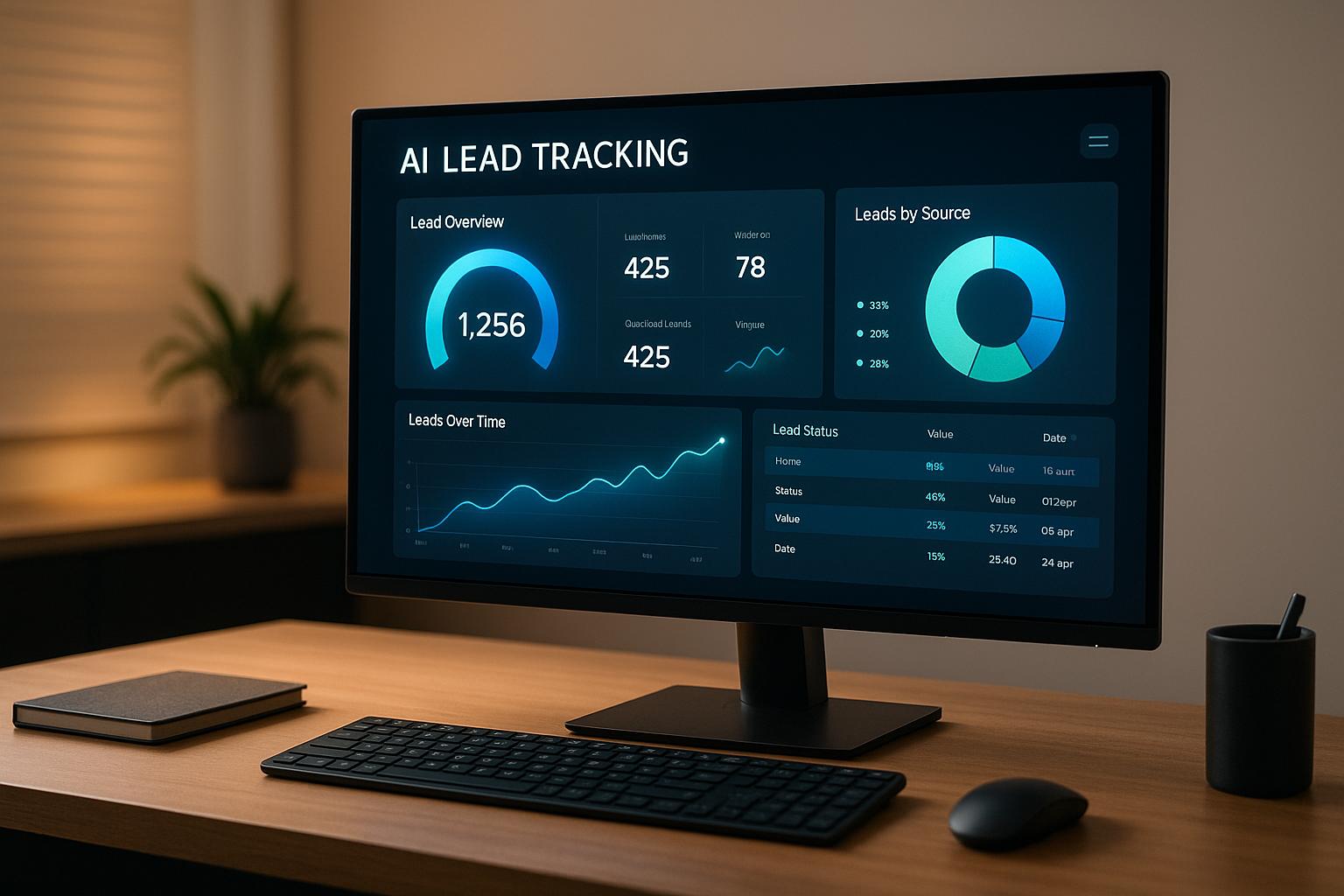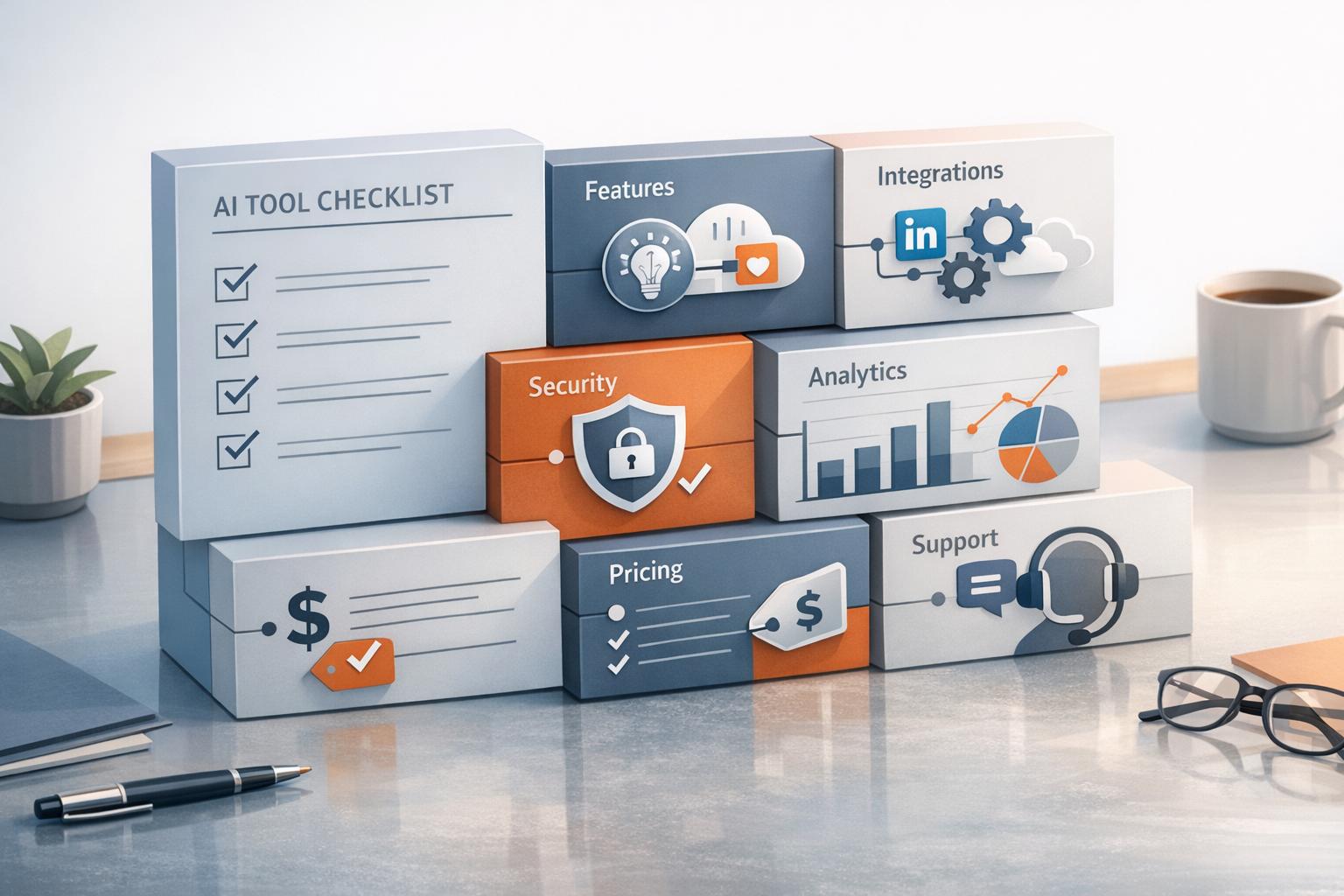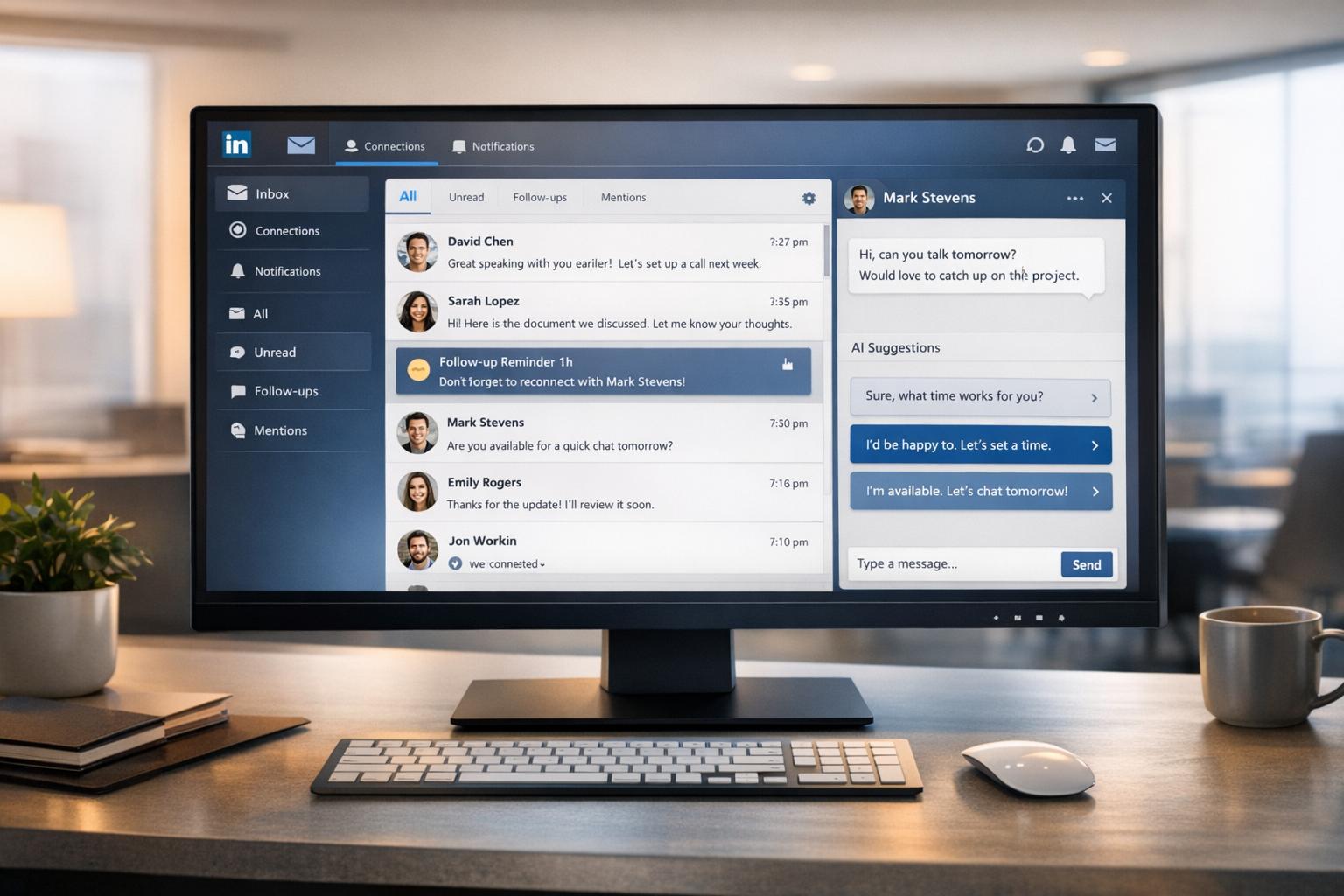
Sales teams lose over 70% of their week to non-selling tasks like admin work and deal prep. This inefficiency often leads to missed opportunities. But with real-time lead tracking and AI dashboards, you can transform how your team captures, qualifies, and converts leads.
Here’s how it works: AI-powered tools track and analyze prospect activity instantly - whether it’s opening an email, engaging on LinkedIn, or requesting a demo. Sales reps get immediate alerts, so they can act while interest is high. These dashboards also automate tasks like lead scoring and follow-ups, freeing up time for closing deals.
Key Benefits:
- Faster response times: Engage leads while they’re active, increasing conversion chances.
- Improved focus: AI highlights high-priority leads, so reps know where to invest their energy.
- Higher efficiency: Automate repetitive tasks like follow-ups and data analysis.
- Better results: Boost conversion rates by 20–50% and reduce sales cycles.
Tools like SalesMind AI integrate LinkedIn and CRM data into one dashboard, offering personalized messaging, predictive analytics, and real-time insights. Users report a 40% acceptance rate on outreach and $100,000+ monthly pipeline values.
Setting up these dashboards is simple: connect your CRM, define metrics (like lead scores and response times), and configure alerts for high-value leads. With U.S.-specific settings like MM/DD/YYYY date formats and USD currency, these tools are tailored for local businesses.
3 Tools to Make AWESOME Sales Dashboards with AI (ChatGPT, Zebra AI & Copilot)
Setting Up an AI-Powered Lead Tracking Dashboard
Getting your AI-powered lead tracking dashboard up and running doesn't have to be complicated. With the right preparation and a structured approach tailored to U.S. business practices, you can streamline the process and ensure everything is set up for success.
What You Need Before Getting Started
Before diving in, make sure you have the following:
- An active and well-optimized LinkedIn account.
- Access to your CRM and any necessary API keys to establish secure connections.
- Administrative access to systems like email marketing platforms, website analytics tools, and social media management software.
Data security is a top priority, especially when integrating multiple platforms. For U.S. businesses, this means ensuring your dashboard complies with relevant data protection standards. Look for tools that offer encrypted connections and strong authentication protocols to safeguard sensitive information.
Next, identify your primary lead generation channels. Whether it's LinkedIn, email, website forms, or phone calls, knowing where your leads come from will help you configure the tracking integrations effectively. Once you've gathered these essentials, you’re ready to connect your data sources.
Step-by-Step Dashboard Setup
-
Connect Your Data Sources
Use the API keys you’ve collected to link your CRM and other platforms. Most modern dashboards can integrate with hundreds of data sources, including Google Analytics, Google Ads, and social media platforms. For users of tools like SalesMind AI, this process is simplified through a unified interface that consolidates LinkedIn and CRM data into a single, easy-to-manage inbox. -
Define the Metrics to Track
Focus on key metrics like conversion rates, lead response times, lead source attribution, and engagement scores. For more advanced setups, you can also track metrics such as call activity duration, form submission rates, and AI-powered lead scoring. These insights ensure your dashboard captures the real-time data needed for timely sales actions. -
Set Automated Alerts
Configure notifications for high-priority leads. For instance, you can set alerts to trigger when a valuable lead enters your pipeline, someone requests a demo, or a follow-up is urgently needed. Imagine a missed call from a top prospect automatically prompting an email alert and scheduling a callback - this keeps your team responsive and proactive. -
Create Custom Views for Team Roles
Tailor dashboard views to meet the needs of different team members. Sales reps might require detailed lead information and suggested next steps, while managers benefit from pipeline overviews and forecasting data. Most platforms allow you to filter and segment data, making it easy to create personalized dashboards for each role.
Configuring for U.S. Standards
To ensure your dashboard aligns with U.S. conventions, follow these guidelines:
- Monetary Values: Display dollar amounts in U.S. currency with standard formatting (e.g., $10,000) for metrics like deal values and revenue projections.
- Date Format: Use the MM/DD/YYYY format for tracking timelines, follow-up schedules, and campaign performance.
- Number Formatting: Apply commas as thousand separators and periods for decimals, such as 1,250 leads or a 15.7% conversion rate. Many platforms like Databox allow you to set U.S. locale preferences, automatically applying these formats.
- Time Zones: Configure time zones based on your main office location but ensure the system can display local timestamps when needed. This helps sales reps schedule outreach during optimal times for prospects.
- Report Scheduling: Set reports to generate during standard business hours and align alerts and reminders with typical U.S. work schedules. This ensures your team receives actionable insights without disrupting their workflow.
Key Metrics for Real-Time Lead Tracking
With your dashboard set up, it's time to focus on the metrics that truly influence your sales decisions.
Important Metrics to Track
Keeping an eye on the right metrics can significantly boost your sales performance. For instance, tracking the lead source helps pinpoint which channels - like LinkedIn campaigns, Google Ads, or website forms - are bringing in the best prospects. This insight allows you to allocate your marketing dollars more effectively.
Another crucial metric is the conversion rate, which measures how many leads turn into paying customers. Breaking it down by funnel stages can reveal where improvements are needed. For example, if your overall conversion rate is 15.7% but a specific campaign only converts at 8.2%, that campaign might need a closer look.
Lead scores, often powered by AI, are another game-changer. By analyzing factors like engagement and interaction frequency, AI assigns a score (e.g., 1 to 100) to each lead, helping you prioritize. Leads scoring above 70, for example, could signal high potential and deserve immediate attention.
Time to first contact is critical as well. Studies show that responding within five minutes can increase qualification success by up to 10×[2]. Your dashboard should track this in real-time, with alerts for any delays that exceed your target response time.
Follow-up status is another area where many teams fall short. Nearly half of sales reps fail to follow up after the first attempt, leaving valuable opportunities untapped. Tracking follow-up progress ensures these leads don’t slip through the cracks.
For calls, metrics like duration, answer rates, and completed callbacks provide valuable insights. Longer call durations often suggest higher interest, and AI-generated summaries can highlight key takeaways and next steps.
Lastly, track revenue in USD to measure the financial impact of your efforts. Break it down by source, campaign, and sales rep to understand where your team is excelling.
Using Metrics for Decision-Making
The real value of metrics comes from turning them into actionable insights. Start by setting clear benchmarks tailored to your industry and company size. If your conversion rates drop, dive into the data to identify the root cause. It could be anything from an underperforming lead source to a campaign attracting low-quality prospects.
Lead scoring can streamline your team’s daily workflow. Configure your dashboard to highlight high-priority leads - say, those scoring above 75 - and route them to your top-performing sales reps. This ensures your team focuses on the leads most likely to convert.
Response time metrics are another area to monitor closely. If the average time to contact a lead starts to climb, it might be time to reassign resources or adjust your alert settings.
Revenue analysis can guide smarter marketing investments. By identifying which lead sources bring in the most revenue, you can allocate your budget more effectively. Additionally, tracking follow-up completion rates can uncover bottlenecks in your process. If leads stall after the first contact, consider refining your scripts or offering additional training.
How to Display and View Metrics
Visualizing your data effectively is just as important as tracking it. Trend lines work well for showing changes in lead volume and conversion rates over time, helping you spot patterns and growth opportunities. Place these charts prominently on your dashboard for easy monitoring.
Bar charts are ideal for comparing performance across lead sources, campaigns, or team members. Adding a color-coded system - green for exceeding targets, yellow for warning zones, and red for areas needing improvement - can make it easier to identify where to focus your efforts.
Tables are great for detailed, actionable data. Include sortable columns for lead scores, contact details, last interaction dates, and next steps. Be sure to format monetary values in U.S. conventions (e.g., $5,000.00), use MM/DD/YYYY for dates, and include commas for thousands (e.g., 1,250 leads).
| Metric Type | Best Visualization | U.S. Format Example |
|---|---|---|
| Revenue Trends | Line Charts | $125,000.00 monthly |
| Lead Source Performance | Bar Charts | 1,250 leads from LinkedIn |
| Lead Details | Sortable Tables | Score: 87/100, Value: $15,000 |
| Conversion Rates | Percentage Displays | 15.7% overall conversion |
Interactive features can further enhance usability. Filters let team members sort data by date ranges, lead sources, or assignment status. Drill-down options allow users to explore specific metrics, such as which leads contributed to a conversion rate. Automated refresh intervals - every 5 to 10 minutes - ensure your team always has up-to-date information, which is crucial for time-sensitive actions like follow-ups.
Real-time metrics become even more powerful when paired with tools like SalesMind AI. Platforms like this integrate LinkedIn, email, and CRM data into a single view, eliminating the need to juggle multiple systems. This unified approach provides complete lead histories and AI-powered recommendations, helping your team act decisively and efficiently.
sbb-itb-817c6a5
Customizing Dashboards for Better Insights
Fine-tuning your dashboard setup is more than just a cosmetic upgrade - it’s about aligning data with the specific needs of each team role. Custom dashboards make it easier to translate raw data into actionable sales insights that can drive results.
Creating Views for Different Team Roles
Sales representatives thrive on dashboards that focus on their daily activities and personal performance. Their view should feature assigned leads, upcoming follow-ups, and engagement history. Prioritize high-scoring leads and recent interactions - like LinkedIn messages or email responses - that need immediate attention. A clear, task-oriented layout helps reps stay on track to close deals efficiently.
Sales managers require a broader perspective that balances team and individual performance. Their dashboards should include team activity summaries, lead source breakdowns, and progress against monthly goals. Key metrics like average response times, conversion rates by rep, and pipeline health indicators allow managers to pinpoint coaching opportunities and shift resources where needed.
Executives need dashboards showcasing high-level KPIs tied directly to business outcomes. Metrics like total leads generated, overall conversion rates, and revenue impact (in USD) should be front and center. Add trend analysis, such as month-over-month growth, ROI by marketing channel, and forecasted pipeline value, to guide strategic decisions on budget allocation and business direction.
Most platforms offer tools to customize layouts, filters, and access permissions, ensuring each role sees only the data that matters to them. These tailored views also set the stage for automated alerts that keep everyone proactive.
Setting Up Automated Alerts and Notifications
Once dashboards are personalized, automated alerts ensure your team stays informed and ready to act. Real-time notifications can flag hot leads, such as when a high-scoring prospect (e.g., a lead with a score above 80) engages with your content or responds to outreach. These alerts ensure no opportunity is missed.
Missed follow-up alerts are another must-have. Configure notifications to trigger when a follow-up is overdue or skipped, preventing valuable leads from slipping through the cracks.
Status change notifications play a crucial role in keeping the team aligned. Alerts can notify relevant members when a lead progresses to a new stage, requests a demo, or shows buying intent. This ensures smooth transitions between marketing and sales teams.
SalesMind AI takes this a step further with its AI co-pilot feature, which provides timely reminders and updates within a unified inbox. As one user shared:
"Amazing tool that allowed me to save so much time on my LinkedIn outreach. But that's not all, by automating all conversations and personalizing them with direct insights extracted from my prospect profiles, it gives accurate and high-quality outputs that helped me get more prospect meetings and thus close more deals! It's definitely a game changer, thanks for this great tool!" - Sébastien D., Freelance - Information Services, Freelance Insider [1]
With automated messaging and follow-ups, your team can maintain consistent engagement while reducing manual work and improving responsiveness.
Building Custom Reports and Charts
Custom reports and charts bring clarity to complex data, making it easier to spot trends and opportunities.
- Performance trend reports: Use line charts to track changes in metrics like lead volume, conversion rates, and revenue over time. These visuals can help uncover seasonal patterns or growth opportunities.
- Lead source analysis: Bar charts work well to compare how different channels perform, showing which sources generate the most leads and deliver the highest revenue.
- Custom segmentation: Filter data by region, campaign, or individual sales reps for more focused insights. For example, compare East Coast versus West Coast performance or analyze LinkedIn campaigns against email outreach.
- Conversion funnel reports: Pinpoint where leads drop off in the sales process. A noticeable decline between initial contact and the first meeting could indicate a need to refine your messaging or lead qualification strategy.
Interactive elements, like the ability to drill down into specific metrics or adjust date ranges, make these reports even more powerful. Automated refresh intervals ensure your team always has up-to-date data for quicker decisions. These reports not only provide clarity but also lay the groundwork for leveraging AI in advanced lead qualification.
Using AI for Advanced Lead Qualification and Reporting
AI has taken lead qualification to a whole new level, transforming it from a tedious manual task into an automated system that delivers actionable insights. By pairing customized dashboards with AI, businesses can now achieve real-time scoring, smarter follow-ups, and predictive analytics. While dashboards simplify data visualization, AI dives deeper, analyzing this data to help sales teams prioritize leads and make informed decisions in real time.
AI-Powered Lead Scoring and Qualification
Traditional lead scoring methods often fall short because they're static, relying on outdated data points. AI changes the game by continuously analyzing engagement metrics like email opens, website visits, social media interactions, call durations, and form submissions. This dynamic approach can generate up to 50% more qualified leads while reducing acquisition costs[2].
Speed is everything when it comes to lead response. AI systems can instantly flag high-priority prospects - say, someone who repeatedly visits pricing pages or actively engages with outreach emails - so sales teams can focus on the most promising opportunities.
Take SalesMind AI, for example. This tool analyzes prospect profiles to deliver personalized insights, making outreach more effective. As one user, Sébastien D., shared:
"By automating all conversations and personalizing them with direct insights extracted from my prospect profiles, it gives accurate and high-quality outputs that helped me get more prospect meetings and thus close more deals!" - Sébastien D., Freelance, Freelance Insider [1]
AI also identifies behavioral patterns that signal buying intent. For instance, a lead who downloads whitepapers, attends webinars, and engages with LinkedIn content will be assigned a higher score than someone with minimal interaction. This ensures that sales teams are always targeting the right leads.
Automating Follow-Ups and Outreach
Did you know that nearly half of sales reps don’t bother with a second follow-up[2]? That’s a lot of missed opportunities. AI automation solves this problem by ensuring consistent, personalized engagement throughout the sales cycle.
SalesMind AI, for instance, offers a unified inbox that consolidates LinkedIn replies from multiple accounts into one place. Its AI co-pilot feature suggests responses, tags, and reminders, so no lead slips through the cracks. The platform even automates LinkedIn message sequences and connection requests, focusing on the top leads identified through AI. Users have reported generating over 10 sales calls per month directly from LinkedIn[1].
"SalesMind AI has elevated my LinkedIn experience... The tangible results in terms of high-quality leads and business growth speak volumes." - Bennett Newhook, Founder, Outport [1]
AI chatbots also play a crucial role by engaging website visitors around the clock. They can answer questions, schedule meetings, and hand off conversations to human sales reps while the prospect’s interest is still fresh. This seamless automation not only keeps leads engaged but also sets the stage for predictive analytics to guide future strategies.
Predictive Analytics and Goal Tracking
AI doesn’t just help with current leads - it predicts future outcomes, too. By analyzing historical and real-time data, AI models can forecast lead conversion rates, sales pipeline velocity, and revenue projections. For U.S. businesses, these forecasts are presented in familiar formats, such as MM/DD/YYYY for dates and dollar signs for currency, making it easy to track progress.
These insights help sales teams set realistic monthly and quarterly goals. Dashboards provide a clear view of performance against targets, enabling quick adjustments to strategies if needed. AI also offers "next best action" recommendations, replacing guesswork with data-driven decisions.
The results speak for themselves: AI-powered lead tracking has boosted conversion rates by 20–50% and shortened sales cycles in industries like SaaS and telecom[2]. By prioritizing the right leads, automating follow-ups, and making informed decisions, businesses can allocate resources more efficiently and see measurable improvements in their sales performance.
The Future of Lead Tracking with AI Dashboards
Lead tracking is undergoing a major transformation, with AI dashboards taking center stage in reshaping how U.S. businesses manage sales and leads. Advances in real-time analytics and automated qualification are revolutionizing sales automation, offering tools that not only streamline processes but also deliver hyper-focused insights for better decision-making. At the heart of this shift are AI-powered tools that enable personalized outreach and smarter lead prioritization.
Hyper-personalization at scale is quickly becoming the gold standard in sales outreach. AI can now analyze detailed prospect data to craft messages that go far beyond a simple personalized greeting. It’s about understanding a prospect's unique business challenges, industry trends, and engagement history to create meaningful, relevant conversations that resonate on a deeper level.
AI is also transforming lead qualification and prioritization. By analyzing multiple data points - such as LinkedIn activity, email interactions, and website behavior - AI algorithms can identify which prospects are most likely to convert. This allows sales teams to focus their time and energy on high-potential leads instead of wasting resources chasing cold prospects. The result? A more efficient, data-driven approach to sales.
Another game-changer is the rise of AI-powered communication hubs that centralize all lead interactions. These platforms bring every email, call, and engagement into a single, intelligent interface. This unified view ensures that no lead is overlooked while giving sales teams complete visibility into the sales pipeline. It’s a seamless way to keep track of every interaction and maintain momentum throughout the sales process.
What makes this technology even more exciting is its continuous evolution. As Erwan C., CEO of Intangible Capital Value, pointed out:
"Probably 3 years ahead and new features every month!" - Erwan C., CEO, Intangible Capital Value - Finance Services [1]
This rapid pace of development means AI dashboards are constantly improving, becoming smarter and more intuitive with each update. For U.S. businesses, this means tools that not only align with local market needs but also adapt to changing regulations and business dynamics.
Looking ahead, the future of lead tracking is all about freeing up sales teams to focus on what they do best - building relationships and closing deals. With AI handling tasks like data analysis, lead scoring, and automated follow-ups, sales professionals can dedicate their time to activities that directly drive revenue.
As these tools continue to advance, we can expect deeper integration with existing business systems, more precise predictive analytics, and even more tailored customer experiences. Businesses that adopt these AI-driven solutions now will position themselves for a competitive edge in the future marketplace.
FAQs
How do AI-powered dashboards enhance real-time lead tracking for my sales team?
AI-powered dashboards can take your sales team's productivity to the next level by offering real-time insights into how leads are interacting and engaging. These tools monitor crucial metrics like response times, interaction history, and the likelihood of conversion, helping your team zero in on high-priority prospects with precision.
With features such as advanced lead scoring and actionable analytics, your team can focus their efforts where it matters most. Plus, by automating routine tasks like follow-ups, these dashboards free up valuable time. The result? A smoother workflow, better time management, and fewer missed opportunities to close deals.
What key metrics should I track on an AI-powered lead tracking dashboard?
When building an AI-powered lead tracking dashboard, it’s crucial to zero in on metrics that offer clear insights into your sales pipeline and how prospects are engaging. Here are some key areas to monitor:
- Lead Source Performance: Identify which platforms or channels - like LinkedIn or email - are bringing in the most high-quality leads. This helps you allocate resources more effectively.
- Lead Conversion Rates: Keep an eye on how efficiently leads are moving through your sales funnel, from the first interaction to closing the deal. This metric highlights bottlenecks or areas needing improvement.
- Engagement Metrics: Track how prospects are responding to your outreach efforts. Metrics like email open rates and response rates can reveal how interested your leads are.
- Lead Scoring: Leverage AI to assign scores to leads based on their likelihood to convert. This ensures your team focuses on the most promising opportunities.
By keeping these metrics front and center, you’ll be better equipped to refine your outreach efforts and boost overall sales performance.
How does AI improve lead qualification and follow-ups compared to traditional methods?
AI takes the hassle out of lead qualification and follow-ups by automating tasks that would otherwise eat up valuable time. For instance, it can handle personalized messaging and lead scoring with ease. By evaluating prospects against set criteria, businesses can zero in on the leads most likely to convert.
On top of that, AI tools simplify follow-ups by scheduling reminders, crafting tailored messages, and monitoring engagement. This keeps communication consistent and boosts the odds of turning potential leads into loyal customers.


.avif)


